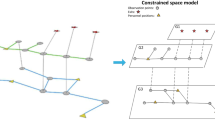Abstract
When an underground mall is flooded, the shoppers should be evacuated to a building connected to the mall. However, the number of evacuees from a large-scale underground mall will exceed the capacity of the evacuation center. Furthermore, the evacuation time may be delayed. This paper proposes a mathematical programming problem that minimizes the evacuation completion time on a general planar graph of a partitioned evacuation area with a specified sink capacity. We also propose a workflow for translating the general geometric spatial data to graphical data. The problem is applied to the real spatial data and evacuation setting of Umeda underground mall in Osaka, Japan. The problem’s performance is compared with that of the conventional problem that minimizes the total evacuation distance, and its accuracy is confirmed in a multi-agent simulation. The validity of the proposed method is also discussed.








Similar content being viewed by others
References
Osaka Prefecture (2013). About the tsunami inundation assumption (commentary). http://www.pref.osaka.lg.jp/attach/31241/00271160/95kaisetu.pdf. Accessed 1 Dec 2018.
Osaka City Underground Space Infiltration Council (2016). Underground space flood control plan of Osaka station area, ver.1 (reference, latter half). http://www.city.osaka.lg.jp/kikikanrishitsu/cmsfiles/contents/0000259/259323/osakaekitiku-shinsuitaisakukeikaku3.pdf. Accessed 1 Dec 2018.
Takizawa, A., Takagi, N., & Taniguchi, Y. (2015). Vertical evaluation simulation in Umeda underground mall in case of flooding. Annual Journal of Unban Disaster Reduction Research, 2, 35–38.
Mamada, S., Uno, T., Makino, K., & Fujishige, S. (2005). A tree partitioning problem arising from an evacuation problem in tree dynamic networks. Journal of the Operations Research Society of Japan, 48(3), 196–206.
Helbing, D., Farkas, I., Molnar, P., & Vicsek, T. (2001). Simulating of pedestrian crowds in normal and evacuation situations. In M. Schreckenberg & S. D. Sharma (Eds.), Pedestrian and evacuation dynamics (pp. 21–58). Berlin: Springer.
Ford, L. R., & Fulkerson, D. R. (1958). Constructing maximal dynamic flows from static flows. Operations Research, 6, 419–433.
Ford, L. R., & Fulkerson, D. R. (1962). Flows in networks. Princeton: Princeton University Press.
Minieka, E. (1973). Maximal, lexicographic, and dynamic network flows. Operations Research, 21, 517–527.
Takizawa, A., Inoue, M., & Katoh, N. (2012). An emergency evacuation planning model using the universally quickest flow. The Review of Socionetwork Strategies, 6, 15–28.
Yang, K. S., Shekhar, A. H., Oliver, D., & Shekhar, S. (2013). Capacity-constrained network-Voronoi diagram: A summary of results. In Advances in Spatial and Temporal Databases—13th International Symposium, pp. 56–73.
Kamiyama, N., Katoh, N., & Takizawa, A. (2006). An efficient algorithm for evacuation problem in dynamic network flows with uniform arc capacity. IEICE Transaction on Fundamentals, E89-D(8), 2372–2379.
Kimura, T., Sano, T., Hayashida, K., Takeichi, N., Minegishi, Y., Yoshida, Y., et al. (2009). Representation of crowd in multi-agent model—development of pedestrian simulation system Simtread. Journal of Architecture and Planning (Transactions of AIJ), 74(636), 371–377.
Acknowledgements
This study is partially supported by Grant-in-Aid for Scientific Research (A) and JST CREST innovative algorithm foundation for big data.
Author information
Authors and Affiliations
Corresponding author
Additional information
Publisher's Note
Springer Nature remains neutral with regard to jurisdictional claims in published maps and institutional affiliations.
Rights and permissions
About this article
Cite this article
Yamamoto, R., Takizawa, A. Partitioning Vertical Evacuation Areas in Umeda Underground Mall to Minimize the Evacuation Completion Time. Rev Socionetwork Strat 13, 209–225 (2019). https://doi.org/10.1007/s12626-019-00037-1
Received:
Accepted:
Published:
Issue Date:
DOI: https://doi.org/10.1007/s12626-019-00037-1




